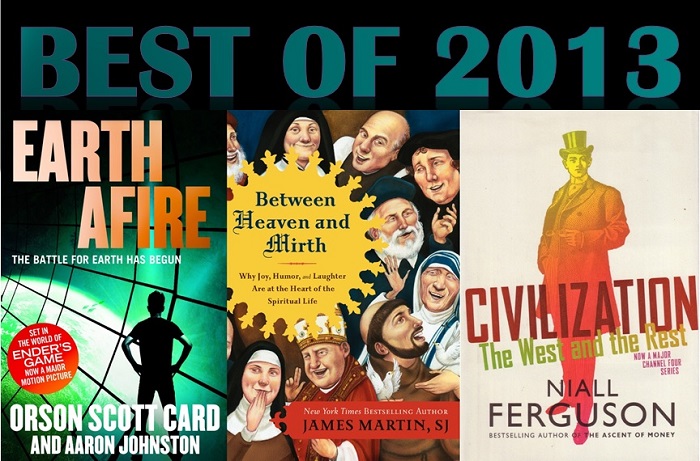
1–“Earth Afire,” Orson Scott Card and Aaron Johnston. The second title in the Formic wars series, the prequels to “Ender’s Game,” moves along at a brisk pace with action a-plenty, rarely boring the reader. As well, the book looks at family relationships (sometimes too much) and the nature of power, those who wield it, and those who want it and seek it.
2–“Civilization: The West and the Rest,” Niall Ferguson. A wide-ranging look at how the small nations of the west developed to the point of overtaking the huge Chinese and Ottoman empires, which were significantly more advanced in almost everything, and became the force to be reckoned with during the past 500 years. And, Ferguson also gives a warning to the West, as well.
3–“Between Heaven and Mirth,” James Martin, SJ. An enjoyable, refreshing book that takes a look at a very serious issue – the absolute necessity of humor in a fully-rounded and spiritually mature person. Using examples from his own life, as well as those of Catholic saints and others, Martin lightens the heart, enlightens the mind and generally gives a breath of fresh air to believers of all faiths.
4–“The Joy of Hate,” Greg Gutfeld. A sometimes fall-down-laughing book dealing with all kinds of modern issues, but the heart of it is that too many people are outraged at things that aren’t outrageous. Gutfeld is every bit as funny as people say he is – the ones he doesn’t pay to say that, I mean – and the perfect up-and-coming replacement for P.J. O’Rourke, when he decides to retire.
5–“Pop,” Gordon Korman. Korman has made a career of writing great humor novels for the young adult market. Here he mixes the humor with some seriousness and tragedy, looking at the reasons people love playing football, and also sounding a warning bell about the dangers within the sport.
6–“The Hangman’s Daughter,” Oliver Potzsch. An excellent historical mystery set in Germany during the Middle Ages. Potzsch creates a rich mystery that evokes the times of which he writes, full of detail – the nice and not so nice – complete with interesting characters that you want to meet again and again. And he’s continued to work with them, which is a good thing.
7–“The Gate Thief,” Orson Scott Card. Card continues working in his very first deliberate trilogy and keeps things very interesting as he looks here at power and creates a heady blend of the world’s mythologies and his own LDS theology, spanning two worlds. I’m excited to see how he finishes this.
8–‘To Mormons with Love,” Chrissy Ross. Ross, a non-Mormon living somewhere in mid-Utah County (Happy Valley), has come to love the LDS community she and her family relocated to because of her husband’s job transfer. Despite her non-desire to ever join the LDS faith, Ross loves her community and considers the LDS ward she lives in to be her ward. This love letter from a friend and admirer is warm, sweet and funny as well as surprisingly deep. A must-read for every Mormon member missionary.
9–“Princess of the Silver Woods,” Jessica Day George. Utah-based writer George follows in the giant footsteps of Robin McKinley by taking favorite fairy tales and turning them on their heads. Here she deftly mixes “Little Red Riding Hood” and the “Twelve Dancing Princesses,” with spectacular results. Danger mixed with humor and a loving hand. Wonderful is all I can say.
10-“Marvel Comics: The Untold Story,” Sean Howe. Howe looks deeply into the past of comics giant and 600-pound gorilla Marvel Comics. He tracks the company’s beginnings in its pre-World War II days (a scrappy underdog who dared to compete with Superman and Batman) to the giant it is today. Complete with interviews, press clippings and many other sources, Howe’s book is definitely worth the time for those interested in the history of comics.
Rich welcomes questions and comments from readers. You may contact him through this paper or by e-mail at [email protected]
Written by Rich Rogers



